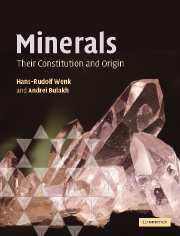Book contents
- Frontmatter
- Contents
- Preface
- Acknowledgments
- Figure credits
- Part I Structural features of minerals
- Part II Physical investigation of minerals
- Part III Variety of minerals and mineral-forming processes
- 14 Classification and names of minerals
- 15 Mineral identification of hand specimens
- 16 Mineral genesis
- 17 Stability of minerals. Principles of thermodynamics
- 18 Solid solutions
- Part IV A systematic look at mineral groups
- Part V Applied mineralogy
- Appendices
- Glossary
- References
- Index
- Plate section
- References
14 - Classification and names of minerals
from Part III - Variety of minerals and mineral-forming processes
- Frontmatter
- Contents
- Preface
- Acknowledgments
- Figure credits
- Part I Structural features of minerals
- Part II Physical investigation of minerals
- Part III Variety of minerals and mineral-forming processes
- 14 Classification and names of minerals
- 15 Mineral identification of hand specimens
- 16 Mineral genesis
- 17 Stability of minerals. Principles of thermodynamics
- 18 Solid solutions
- Part IV A systematic look at mineral groups
- Part V Applied mineralogy
- Appendices
- Glossary
- References
- Index
- Plate section
- References
Summary
Minerals, mineral species, and mineral varieties
In the first chapter we defined a mineral as a naturally occurring solid with well-defined chemistry that is formed by geological and biochemical processes. Note that substances formed by human intervention (e.g., products of interaction between seawater and metallurgical slag, or products of coal combustion) are not regarded as minerals. A certain mineral may exist with different morphologies, showing different properties and slight variations in its internal structure. Because of isomorphism the chemical composition of a mineral may also fluctuate. Each particular mineral is therefore a sort of “individual”, much as individual plants or animals within a species differ from each other. Biologists introduced the term species to collect individuals with similar characteristics, basing their definition largely on morphological factors. Similarly, the term mineral species has been introduced to include natural crystals with similar structural and chemical properties.
As an illustration, consider how this term can be used with the garnet mineral group. Garnets have a common formula R13R22(SiO4)3 (R1 and R2 representing two different cations). They crystallize in cubic symmetry, and their morphology typically displays rhombic dodecahedra, irregular grains, or solid masses. Garnets may be white, green, yellow, brown, raspberry-red, pink or black in color, with considerable variations in density, hardness, and refractive index. This variation can be explained in terms of fluctuations in chemical composition due to isomorphism (see Chapter 6).
- Type
- Chapter
- Information
- MineralsTheir Constitution and Origin, pp. 255 - 265Publisher: Cambridge University PressPrint publication year: 2004



